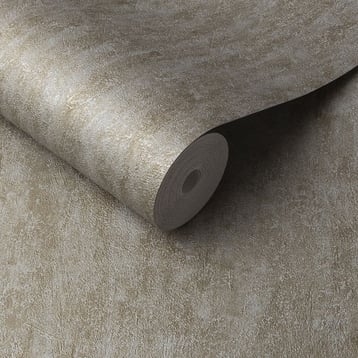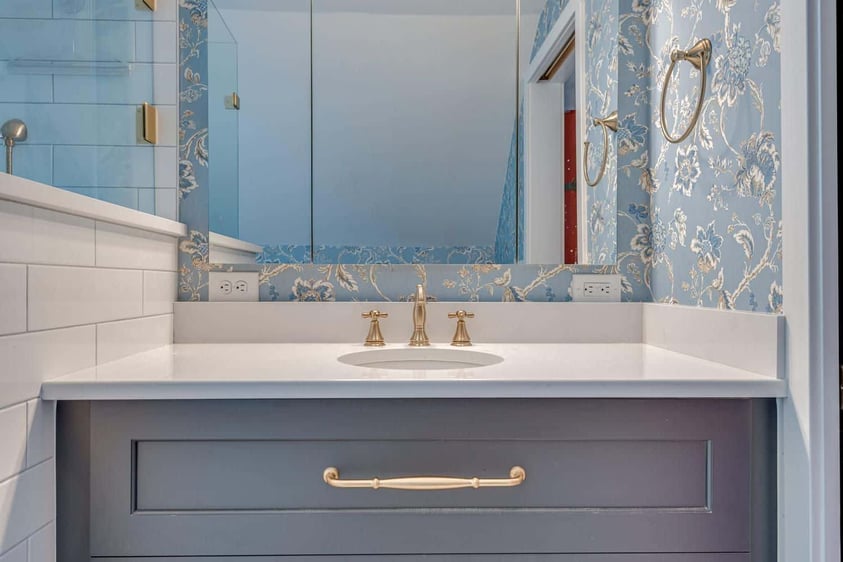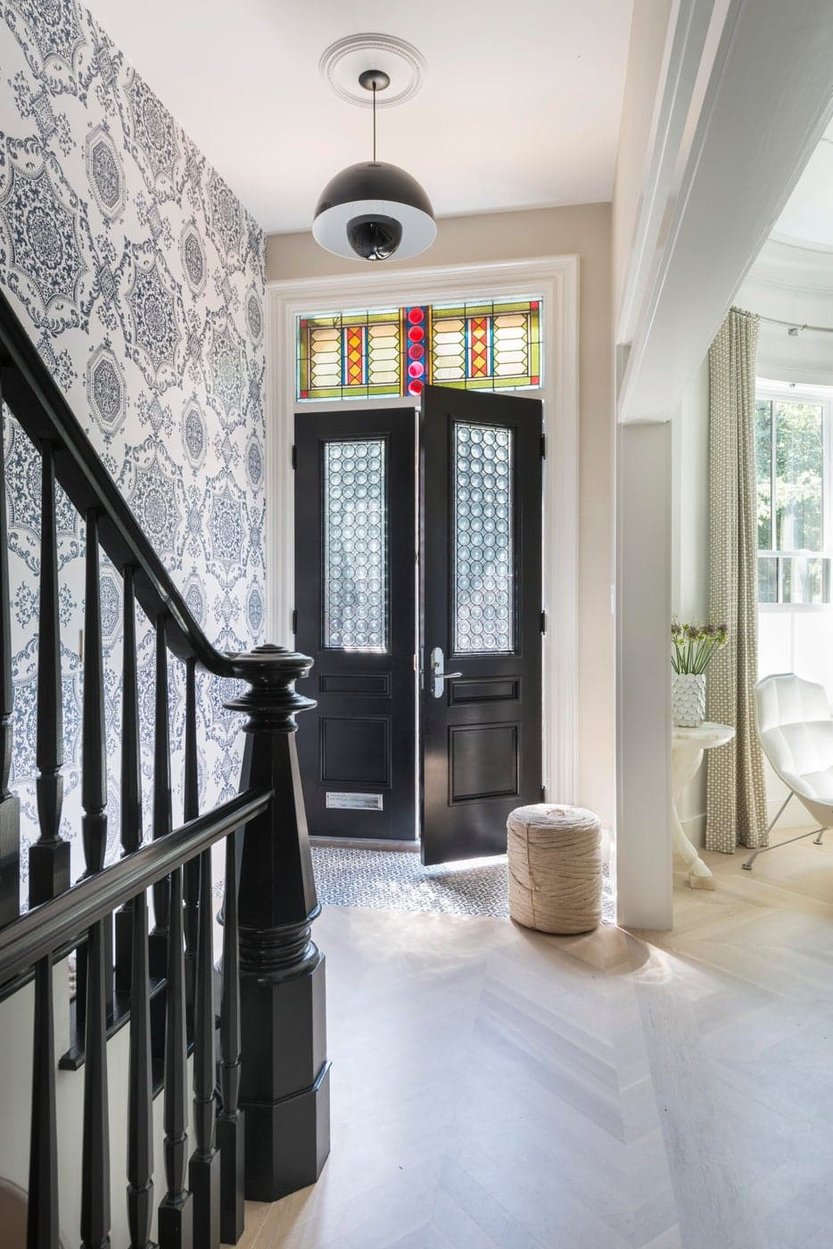Wallpaper is one of those topics that people tend not to have mild opinions on. You either love it or you hate it. Polarizing as it may be, wallpaper has made its way back to the mainstream. Now, many homeowners are beginning to wonder if they can work wallpaper into the design of their upcoming home remodel.
Our design teams at Lamont Bros. work with homeowners to develop personally curated home remodel designs. Several of those recent designs included wallpaper. Rest assured, if wallpaper fits your aesthetic, there are trendy and creative ways to incorporate it into your space.
In this article, you can read all about wallpaper and how it can be used in your home remodel. So, we invite all you wallpaper skeptics and fanatics alike to lay aside your preconceived notions. Wallpaper might not be for everyone, but you just might learn something you didn’t know. Here, you can read about:
- The history of wallpaper
- Different types of wallpaper
- When and how to use wallpaper in a remodel
A brief history of wallpaper

Paper was purportedly invention in China around 105 B.C. It didn’t take long after that for people to start painting it and putting it on their walls.
The earliest form of modern wallpaper made its first appearance in Europe around the 1400s. It would take another 200 years before the concept of repeating wallpaper was invented. This advancement allowed for multiple runs of wallpaper to be joined together, making it possible to cover an entire wall with a seamless pattern.
Unlike current iterations, wallpaper of yore was tacked to the walls rather than pasted, a practice which fell out of use in the 1800s. By the early 20th century, wallpaper had completely taken over. It was everywhere.
The era of floral patterns, simple geometric designs, and muted colors proliferated largely as a result of the ability to cheaply mass-produce popular patterns and distribute them globally.
Inexpensive, colorful, and easy to install, paste-on wallpaper remained a popular interior design trend until the 70s, when it suddenly dropped out of favor with the public.
During the last few years, a wallpaper revival has taken hold in the interior design realm. Digital printing made it easy and inexpensive to produce in smaller batches. At the same time, vintage and transitional design styles present the opportunity to develop modern interpretations of classic interior features.
So, if you start seeing more wallpaper pop up in the latest home remodel projects, realize that it’s just the latest development in a trend that spans hundreds of years.
What are the different types of wallpaper?
With its rich history spanning many centuries, it should be no surprise that wallpaper comes in many different forms. Though many different variations exist, the three main variables in wallpaper construction are the application, base material, and surface finish.
Wallpaper application options
Although the archaic ways of tacking wallpaper to the wall are long gone, there are still several different methods of applying wallpaper. Each one uses some form of surface adhesive, but they differ in benefits and challenges.

Traditional paste-on application
Historically, the most common method of applying wallpaper is to use a separate paste. When hanging wallpaper using this process, the wallpaper comes without any adhesive on it. You must first apply a liquid paste to the wall, then add the wallpaper over top.
Though typically messier and more labor-intensive, this method ensures a firm, permanent adhesion to the wall. It also allows you to apply additional paste to any stubborn areas.
Pre-pasted wallpaper
For those who would rather opt out of using a separate paste, there is a simpler option: wallpaper with pre-applied paste.
These options tend to cost more and offer fewer available patterns, but the ease of application is much higher than traditional pasteless wallpaper. It also eliminates the messy process of brushing your wall with glue.
On the other hand, the adhesive isn’t quite as strong, and you may end up having to re-glue a few edges down the road.
Peel-and-stick
Similar to its pre-pasted counterpart, peel-and-stick wallpaper comes with the adhesive already applied. The difference is that, unlike the other two options, peel-and-stick wallpaper is designed to be removable.
This is a great option for those who are still courting the idea of wallpaper and aren’t ready to commit to the permanence of pasted wallpaper. It also works well for rentals, college dorms, and offices.

Wallpaper materials
You might be surprised to learn that not all wallpaper is actually made of paper. Several different core material options are available, depending on your style, budget, and needs.
Paper
Traditional, versatile, and easy to print, true wallpaper remains an accessible and inexpensive option. Paper is more prone to tearing, so handle with care, even once it’s on the wall.
Vinyl
Wallpaper made from vinyl is sturdy and easy to clean. It’s also waterproof.
Fabric
A fabric wallpaper can add elegance and texture to a space. This type of wallpaper typically comes as a peel-and-stick option rather than a permanent one.

Grasscloth
Grasscloth is an especially popular form of wallpaper renowned for its natural feel. Twice as expensive and difficult to clean, this high-end option is often handmade, hence its high price.
Wallpaper finish options
There are a few options for the surface finish on wallpaper. Each one has varying degrees of protection.
Natural or unfinished
Leaving your wallpaper unfinished can maintain a more natural aesthetic at expense of protection. For grasscloth wallpaper, this is an especially popular option.
Post-installation sealant
Some people choose to apply a sealant after installing the wallpaper. Typically, they’ll use a brush-on polyurethane protective coat. This kind of sealant offers protection from scratches and tears but may also give the surface a higher gloss shine.
Vinyl-coated wallpaper
Paper and cloth-based wallpapers will often come with a protective vinyl layer over the core material. The vinyl coating offers an excellent protective barrier and makes the surface much easier to clean.
When and where to use wallpaper in a home remodel
So, you’re renovating your home and you really want to find a way to incorporate wallpaper into the remodel. While it’s important to remember that oftentimes, less is more, wallpaper can add color and character to a design, often at a minimal cost.
As a design principle, wallpaper is most commonly used to give additional visual impact to a room. It’s also a great way to make the space more your own. With dynamic patterns, added color variety, and different textures, wallpaper is an easy way to customize your home.
There are several places in a home where wallpaper can enhance the space. While those listed below are not an exhaustive list, they should give you a good idea of how you might incorporate wallpaper into your home remodel.
Powder bathroom

Also commonly referred to as a half-bath, the powder bathroom can often be treated as the red-headed stepchild of bathrooms. When was the last time you walked into a downstairs guest bathroom and thought to yourself, “Yep, this is a highlight”?
For those looking to add intentional flair to their powder bathroom, a carefully curated wallpaper behind the mirror wall is a great solution. When it comes to adding wallpaper to a powder bathroom, a little effort can make a big statement.
Entryway

Never underestimate the power of a first impression, especially when it comes to your home. The entryway is the first thing anybody sees when they come into your house. It’s your first chance to impress; to offer a reflection of your taste and personality. One of the best ways to do this is to find a wallpaper that screams, “You!”
Are you upbeat, fun, and spontaneous? Consider a wallpaper that is bright and out-of-the-ordinary with intricate designs.
Do you tend to be reserved and reflective? Or maybe you just prefer more classic, traditional styles? Perhaps you’d be better represented by a time-honored geometric pattern in a gentle accent color, like teal or robin’s egg blue.
Whatever your style preferences, there’s a wallpaper out there that can help your entryway make a great first impression.
Historic homes
Here in the Portland-Metro Area, we have a lot of homes built in the early 1900s. Incidentally, that’s also right around the time wallpaper was at its zenith.
When remodeling a home from this era, the possibilities for wallpaper are nearly endless. One of the best places to put wallpaper is between crown molding and wainscot.
It’s also common to find wallpaper in dining rooms and, on rare occasions, alcove ceilings. You can read more about how to renovate old homes in our article on historic home remodeling in Portland.
Accent walls
The rise in popularity of “accent walls” (also called feature walls) has given wallpaper renewed purpose in the home remodel industry.
Accent walls are usually just painted a different color from the rest of the room. However, when a different color doesn’t quite give enough contrast, wallpaper is here to save the day. The added variance in pattern, texture, and color is almost always enough to make a wall stand out.
This is especially true for more vibrant, exciting wallpapers that only need to be put on one wall to dominate a space.
Is wallpaper right for your next home remodel?
When incorporated correctly into a remodel design, wallpaper can add a strong personal touch to a home. If you think a personally-curated wallpaper might be the perfect final touch for your remodel, a design consultant at Lamont Bros. can help find one just for you. Check out our remodel portfolio to gather more inspiration and get a feel for our work.
When you’re ready to talk to a design consultant about a personal, curated remodel, fill out the form below to schedule a video call.



